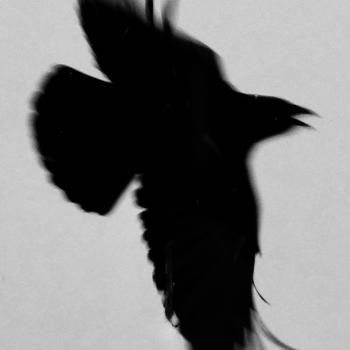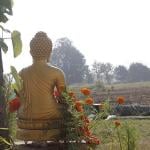
How to cross the flood of sense desires, becoming, views, and ignorance?
Let’s give the Buddha of the Pali Canon the first crack at answering – seems fair given that he is credited with identifying the four contaminants (sense desires, becoming, views, and ignornace). Here’s his old tune from the Samyutta Nikaya:
“The Flood”
Thus have I heard. The Exalted One was once staying near Savatthi at Jeta Grove, in Anathapindika’s Park. Now a certain deity, when the night was far spent, shedding radiance with his effulgent beauty over the whole Jeta Grove, came into the presence of the Exalted One, and coming, saluted him and stood at one side. So standing, he spake thus to the Exalted One:
“How did you, dear sir, cross the flood?”
[The Exalted One:] “Without tarrying, friend, and without hurrying did I cross the flood.”
“But how did you, dear sir, without tarrying, without hurrying, cross the flood?”
“When I friend, tarried, then verily I sank; when I, friend, hurried, then verily I was swept away. And so, friend, untarrying, unhurrying, did I cross the flood.” (1)
A deity “…shedding radiance with his effulgent beauty over the whole Jeta Grove” – Wow! Get a room, dude. But good question. How’d you do it, old Buddha?
And the Buddha just says what he didn’t do. He didn’t tarry and he didn’t hurry. That’s how.
“But how?” asks our radiance shedding friend.
Without tarrying or hurrying, spake the World Honored One, attempting to clarify through reiteration.
Seems like a lot of nondoing.
Scroll ahead about 1,500 years to Dàhuì, the subject of this ongoing series (this is the fifth of ten), and you’ll find some similarities. And some developments.
First, the usual series introduction and disclaimer:
In the recent translation of The Letters of Chan Master Dàhuì Pujue, translators Jeffrey L. Broughton and Elise Yoko Watanabe offer nine themes, motifs, that emerge in the letters about how to do keyword practice (話頭 huàtóu, Japanese, watō). I’ve been sharing them on the Vine of Obstacles: Online Support for Zen Training for students working with keywords, and I’ll also be sharing them here for others who might be interested. Close study of an ancient text can help both students and teachers notice details of the method and refresh their practice spirit. If you are working with a keyword with another teacher, consult with them, of course, and rely primarily on their guidance.
Theme 4: You must be neither “tense” nor “slack”
Broughton and Watanabe: Letters of Dàhuì sets up a polarity of “being tense/in a rush” and “being slack.” Being in a rush leads to the fluttering or restlessness of the perverse teaching or defect called “engirding mind”; being slack leads to the torpor or dark sinking of the perverse teaching or defect called “silence-as-illumination”:
Letter #52.4: In your [diligent practice] you shouldn’t be in a rush [i.e., when raising the wu 無 keyword to awareness]. If you’re in a rush, then you will be restlessly moving. You shouldn’t be slack either. If you’re slack, you will be gloomy and dark. “Quelling delusive thought” and “concentrating mind” are both mistakes.
Letter #3.5: You are already in a neat and tidy state. You maintain a mind of the Way that is firm in the truth [and hence impervious to perverse teachers and teachings]. Don’t pay any attention whatsoever to whether or not your [diligent practice] is “pure.” Don’t just, on the basis of sayings of the ancients, intently be like a multi-storied stupa, piling layer upon layer [of intellectual understanding]. This is expending [diligent practice] [energy] to no avail, and it will never end. If you just maintain mind on a single point, there’s no way that you won’t be able to attain awakening. When the time and conditions arrive, spontaneously it will “click.” With a “snort” you will awaken!
Comments:
1. Dàhuì is talking about being “taut” in diligent practice moment by moment, not only in sitting, but in standing, walking and lying down as well. In the Letters, he doesn’t talk much about zazen specifically, or distinguish zazen from other activities. It is important to note that being taut is a psycho-physical condition, not a private psychological experience. Rather than stillness of mind, or a specific pose like zazen, Dàhuì emphasizes the outcome – “smashing the mind of samsara” (which could also be rendered “breaking birth-death mind”). There’ll be more about that in subsequent posts.
2. What’s meant by “taut” isn’t “tense,” “tight,” or “hard,” but “concise,” “crisp,” “pithy,” and even “sharp.” Gotta give Dàhuì credit. Unlike the Buddha of the Pali Canon, at least he throws us a taut bone. And like the Buddha of the Pali Canon, he also gives us “slack,” and “rushing.” When most people begin keyword work, we are too slack, approaching zazen as letting go only, falling into being gloomy and dark. When the keyword stirs up some serious doubt (yes, as in, “I don’t know shit”), most of us overcompensate and fall into rushing, or engirding the mind. For more on “engirding,” see Let Go of Making the Ground Flutter: More On The Keyword Instruction of Dàhuì.
3. Dàhuì’s teaching also differs from the Buddha of the Pali Canon, in that the latter tended to describe the normal human condition as contaminated. Defiled. Yucky. Dàhuì sees us as already “neat and tidy,” and practicing tautness allows us to realize just how neat and tidy we are. So forget purity and perfection and just do your utmost. Oh, and all that dharma narrative about who said what about this and that, all that cool stuff that you’ve stored up just for the opportunity to lay it out in social media to wow the assembly, well, that’s your fifty-storied building that just blocks the view. Don’t waste energy on such projects! Just realize how neat and tidy you already are.
4. Another difference for Dàhuì, coming from this neat and tidy perspective, is that he skips over the preparatory practices for calming the mind, and begins his instruction with “You are already in a neat and tidy state.” From this point, it’s already about letting go of both rushing (aka, excitement), which Dàhuì identifies with controlling the mind; and slackness (aka, laxity), which he identifies with silent illumination (mòzhào, 默照).
5. Now this next point might cause shock and awe among friends, students, and regular readers. I’m now going to defend silent illumination – something I may never have done before. Silent illumination was a practice common in Dàhuì’s day among some Cáodòng (Japanese, Sōtō) lineages. Essentially, it was a samadhi practice that involved sitting your ass off for many hours a day and trusting that by samadhi alone you would turn into awakening. As somebody who’s tried it, let me tell you, it might work. It also might not. Nevertheless, almost no-one in the current dharma scene who talks about silent illumination sits 10% as much as the old time silent illuminationists. So mostly when the phrase is used in modern dharma discourse, it’s just a name without a practice. Click here for more about this from Hakuin’s perspective.
Anyway, Dàhuì’s keyword method arose as a response to the silent illuminationists wallowing in samadhi as a best-practice initiative to help diligent practitioners maximize their chances of tasting the same mind as Buddha.
In defense of silent illumination, I’ve got to note that Dàhuì often equates silent illumination with slackness (with the deftness of a modern social media master), and although slackness is one of the major barriers to silent illumination, in fairness, that isn’t what the proponents of silent illumination were aiming for.
Hóngzhì beautifully describes silent illumination like this:
“Sky encompasses it, ocean seals it,
every moment without deficiency.
In the achievement without deficiency inside and outside are interfused.
All dharmas transcend their limits, all gates are wide open.
Through the open gates are the byways of playful wandering.” (3)
Not a lot of slack here. And it surely seems to have worked for him.
6. Nevertheless, in terms of crossing the flood, Dàhuì’s method rocks the boat. He goes beyond silent illumination and the Buddha of the Pali Canon who in this passage, at least, just advised what not to do. Nondoing is itself powerful and wonderful. I’d say the Buddha of the Pali Canon got 90% of it. Dàhuì goes beyond 90% by gathering up the kōan narrative (e.g., “This little dog is the buddhanature, no?”) and pointedly culling out and illuminating the keyword method (e.g., mu):
“If you just maintain mind on a single point [e.g., mu], there’s no way that you won’t be able to attain awakening. When the time and conditions arrive, spontaneously it will ‘click.’ With a ‘snort’ you will awaken!”
May all living beings click and snort together!
(1) Samyutta Nikaya, “The Book of the Sayings with Stanzas” (Sagaathaa Vagga) https://www.accesstoinsight.org/lib/authors/nanananda/wheel183.html#passage-1
(2) The Letters of Chan Master Dàhuì Pujue, “Introduction: Recurring Motifs in Huatou Practice,” trans. Jeffrey L. Broughton and Elise Yoko Watanabe.
(3) Taigen Dan Leighton, Cultivating the Empty Field: The Silent Illumination of Zen Master Hongzhi, “Guidepost for the Hall of Pure Bliss,” by Hóngzhì.
Dōshō Port began practicing Zen in 1977 and now co-teaches with his wife, Tetsugan Zummach Sensei, with the Vine of Obstacles: Online Support for Zen Training, an internet-based Zen community. Dōshō received dharma transmission from Dainin Katagiri Rōshi and inka shōmei from James Myōun Ford Rōshi in the Harada-Yasutani lineage. Dōshō’s translation and commentary on The Record of Empty Hall: One Hundred Classic Koans, is now available (Shambhala). He is also the author of Keep Me In Your Heart a While: The Haunting Zen of Dainin Katagiri. Click here to support the teaching practice of Dōshō Rōshi at Patreon.












